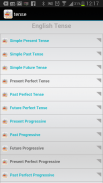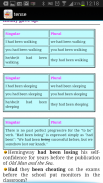




English Tense

Описание English Tense
Tense shows the time of a verb's action or being. There are three inflected forms reflected by changes in the endings of verbs. The present tense indicates that something is happening or being now: "She is a student. She drives a new car." The simple past tense indicates that something happened in the past: "She was a student. She drove a new car." And the past participle form is combined with auxiliary verbs to indicate that something happened in the past prior to another action: "She has been a student. She had driven a new car."
Unlike most other languages, English does not have inflected forms for the future tense. Instead, English future forms are created with the use of auxiliaries: "She will be a student. She is going to drive a new car." English can even create the future by using the present tense, "The bus arrives later this afternoon," or the present progressive, "He is relocating to Portland later next month."
Напряженные показывает время действия глагола или бытия. Есть три формы слова отражается в изменениях в окончаниях глаголов. Настоящее время показывает, что что-то происходит, или быть в настоящее время: "Она студентка Она водит новую машину.". Простого прошедшего времени означает, что что-то произошло в прошлом: ".. Она была студенткой Она поехала новый автомобиль" И прошлое формы причастия в сочетании с вспомогательными глаголами, чтобы указать, что что-то происходило в прошлом до другого действия: ".. Она была во время учебы она загнал новый автомобиль"
В отличие от большинства других языков, английский не имеет словоформ для будущего времени. Вместо этого, формы английского будущем создаются с использованием вспомогательных: ". Она будет во время учебы она собирается сесть за руль нового автомобиля." Английский даже можете создать будущее с помощью настоящего времени ", автобус прибывает во второй половине дня", или Present Progressive "Он переезда в Портленде в конце следующего месяца."
Tense shows the time of a verb's action or being. There are three inflected forms reflected by changes in the endings of verbs. The present tense indicates that something is happening or being now: "She is a student. She drives a new car." The simple past tense indicates that something happened in the past: "She was a student. She drove a new car." And the past participle form is combined with auxiliary verbs to indicate that something happened in the past prior to another action: "She has been a student. She had driven a new car."
Unlike most other languages, English does not have inflected forms for the future tense. Instead, English future forms are created with the use of auxiliaries: "She will be a student. She is going to drive a new car." English can even create the future by using the present tense, "The bus arrives later this afternoon," or the present progressive, "He is relocating to Portland later next month."


























